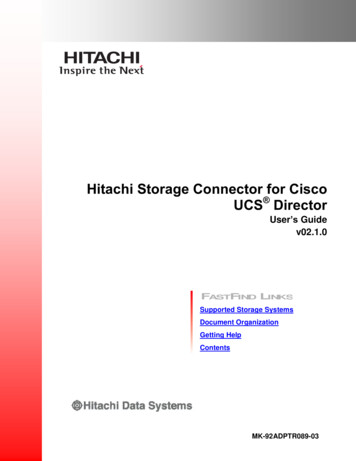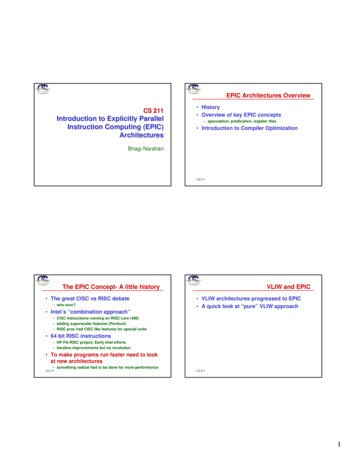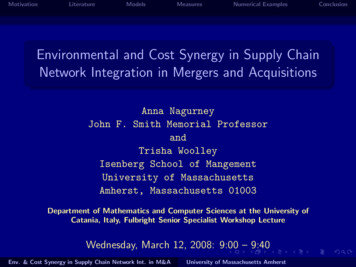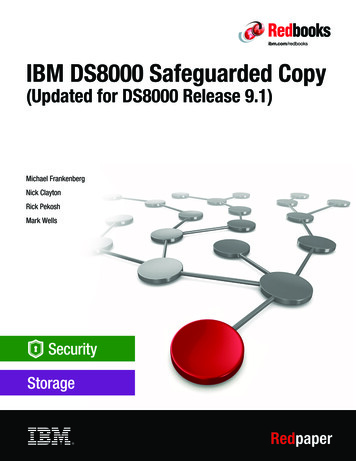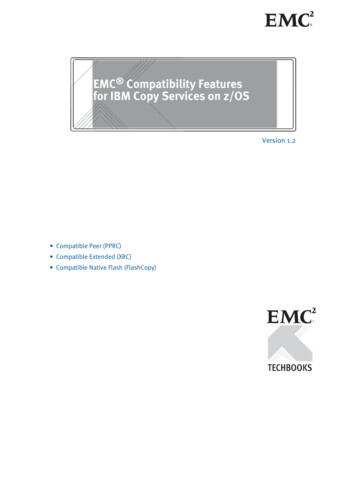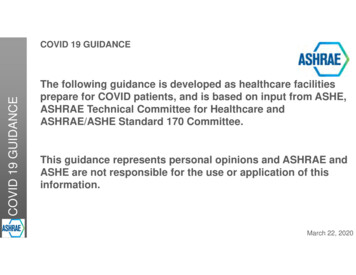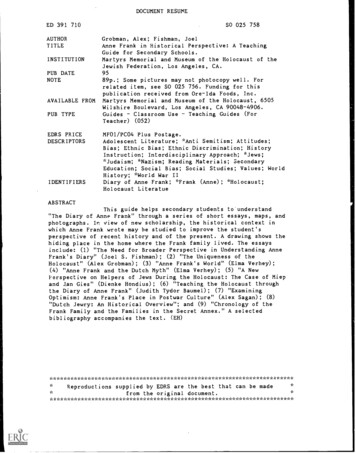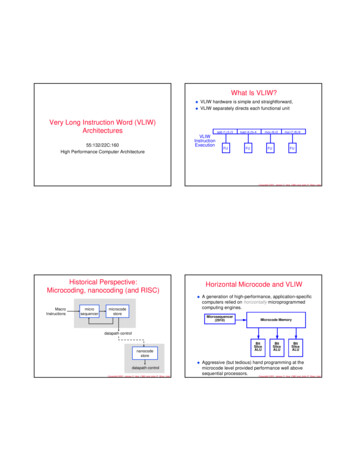
Transcription
What Is VLIW? VLIW hardware is simple and straightforward,VLIW separately directs each functional unitVery Long Instruction Word (VLIW)Architectures55:132/22C:160High Performance Computer ArchitectureVLIWInstructionExecutionadd r1,r2,r3load r4,r5 4FUFUmov r6,r2FUmul r7,r8,r9FUCopyright 2001, James C. Hoe, CMU and John P. Shen, IntelHistorical Perspective:Microcoding, nanocoding (and RISC)Horizontal Microcode and VLIW MacroInstructionsmicrosequencermicrocodestoreA generation of high-performance, application-specificcomputers relied on horizontally microprogrammedcomputing engines.Microsequencer(2910)Microcode Memorydatapath controlBitSliceALUnanocodestore datapath controlCopyright 2001, James C. Hoe, CMU and John P. Shen, IntelBitSliceALUBitSliceALUAggressive (but tedious) hand programming at themicrocode level provided performance well abovesequential processors.Copyright 2001, James C. Hoe, CMU and John P. Shen, Intel
Formal VLIW ModelsPrinciples of VLIW Operation Statically scheduled ILP architecture.Wide instructions specify many independent simple operations. VLIW Instruction100 - 1000 bits Multiple functional units executes all of the operations in aninstruction concurrently, providing fine-grain parallelism withineach instructionInstructions directly control the hardware with no interpretationand minimal decoding.A powerful optimizing compiler is responsible for locating andextracting ILP from the program and for scheduling operations toexploit the available parallel resourcesJosh Fisher proposed the first VLIW machine at Yale (1983)Fisher’s Trace Scheduling algorithm for microcodecompaction could exploit more ILP than any existingprocessor could provide.The ELI-512 was to provide massive resources to a singleinstruction stream- 16 processing clusters- multiple functional units/cluster.partial crossbar interconnect.multiple memory banks.attached processor – no I/O, no operating system.Later VLIW models became increasingly more regular- Compiler complexity was a greater issue than originally envisionedThe processor does not make any run-time control decisionsbelow the program levelCopyright 2001, James C. Hoe, CMU and John P. Shen, IntelIdeal Models for VLIW Machines Almost all VLIW research has been based upon anideal processor model.This is primarily motivated by compiler algorithmdevelopers to simplify scheduling algorithms andcompiler data structures.- This model includes: Multiple universal functional units Single-cycle global register fileand often: Single-cycle execution Unrestricted, Multi-ported memory Multi-way branchingand sometimes: Unlimited resources (Functional units, registers, etc.)Copyright 2001, James C. Hoe, CMU and John P. Shen, IntelCopyright 2001, James C. Hoe, CMU and John P. Shen, IntelVLIW Execution CharacteristicsGlobal Multi-Ported Register tionalUnitInstructionMemorySequencerCondition CodesBasic VLIW architectures are a generalized form of horizontallymicroprogrammed machinesCopyright 2001, James C. Hoe, CMU and John P. Shen, Intel
VLIW Design Issues Realistic VLIW DatapathUnresolved design issues-The best functional unit mixRegister file and interconnect topologyMemory system designBest instruction format Many questions could be answered throughexperimental research Compatibility issues still limit interest in general-purposeVLIW technologyNo Bypass!!No Stall!!Multi-Ported Register FileMulti-Ported Register FileFAdd(1 cycle)FMul4 cyc unpipeFMul4 cyc pipeFDiv16 cycle- Difficult - needs effective retargetable compilersHowever, VLIW may be the only way to build 8-16operation/cycle machines.InstructionMemorySequencerCondition CodesCopyright 2001, James C. Hoe, CMU and John P. Shen, IntelCopyright 2001, James C. Hoe, CMU and John P. Shen, IntelScheduling for Fine-Grain Parallelism The program is translated into primitive RISC-style(three address) operationsDataflow analysis is used to derive an operationprecedence graph from a portion of the originalprogramOperations which are independent can be scheduledto execute concurrently contingent upon theavailability of resourcesThe compiler manipulates the precedence graphthrough a variety of semantic-preservingtransformations to expose additional parallelismExampleA:B:C:D:e (a b) * (c d)b ;Original ProgramADr1 a br2 c de r1 * r2b b 13-Address CodeBCDependency Graph00:add a,b,r1add c,d,r2add b,1,b01:mul r1,r2,enopnopVLIW InstructionsCopyright 2001, James C. Hoe, CMU and John P. Shen, IntelCopyright 2001, James C. Hoe, CMU and John P. Shen, Intel
VLIW List Scheduling Enabling Technologies for VLIWAssign PrioritiesCompute Data Ready List - all operations whose predecessorshave been scheduled.Select from DRL in priority order while checking resourceconstraintsAdd newly ready operations to DRL and repeat for next instruction 514-wide VLIW22333427110115462813392Data Ready List1{1}6345{2,3,4,5,6}9278{2,7,8,9}121011VLIW Architectures achieve high performancethrough the combination of a number of key enablinghardware and software technologies.- Optimizing Schedulers (compilers)- Static Branch Prediction- Symbolic Memory Disambiguation- Predicated Execution- (Software) Speculative Execution- Program Compression{10,11,12}12113{13}13Copyright 2001, James C. Hoe, CMU and John P. Shen, IntelCopyright 2001, James C. Hoe, CMU and John P. Shen, IntelStrengths of VLIW Technology Parallelism can be exploited at the instruction level- Available in both vectorizable and sequential programs. Hardware is regular and straightforward- Most hardware is in the datapath performing usefulcomputations.- Instruction issue costs scale approximately linearlyPotentially very high clock rate Architecture is “Compiler Friendly”- Implementation is completely exposed - 0 layer of interpretation- Compile time information is easily propagated to run time. Exceptions and interrupts are easily managedRun-time behavior is highly predictableWeaknesses of VLIW Technology No object code compatibility between generationsProgram size is large (explicit NOPs)Multiflow machines predated “dynamic memorycompression” by encoding NOPs in the instruction memory Compilers are extremely complex Philosophically incompatible with caching techniquesVLIW memory systems can be very complex- Assembly code is almost impossible - Simple memory systems may provide very low performance- Program controlled multi-layer, multi-banked memory Parallelism is underutilized for some algorithms.- Allows real-time applications.- Greater potential for code optimization.Copyright 2001, James C. Hoe, CMU and John P. Shen, IntelCopyright 2001, James C. Hoe, CMU and John P. Shen, Intel
Real VLIW MachinesVLIW vs. Superscalar [Bob Rau, HP]AttributesSuperscalarVLIWMultiple instructions/cycleyesyesMultiple operations/instructionnoyesInstruction stream parsingyesnoRun-time analysis of registerdependenciesyesnoRun-time analysis of memorydependenciesmaybeRuntime instruction reorderingmaybeRuntime register allocationmaybemaybe(renaming)(iteration frames) VLIW Minisupercomputers/Superminicomputers:-Multiflow TRACE 7/300, 14/300, 28/300 [Josh Fisher]Multiflow TRACE /500 [Bob Colwell]Cydrome Cydra 5 [Bob Rau]IBM Yorktown VLIW Computer (research machine) Single-Chip VLIW Processors:occasionally Single-Chip VLIW Media (through-put) Processors:no DSP Processors (TI TMS320C6x ) Intel/HP EPIC IA-64 (Explicitly Parallel Instruction Comp.)Transmeta Crusoe (x86 on VLIW?)Sun MAJC (Microarchitecture for Java Computing)- Intel iWarp, Philip’s LIFE Chips (research)- Trimedia, Chromatic, Micro-Unity(Resv. Stations) Copyright 2001, James C. Hoe, CMU and John P. Shen, IntelWhy VLIW Now?Copyright 2001, James C. Hoe, CMU and John P. Shen, IntelPerformance Obstacles of Superscalars CPUInstructionCache(1MB)Branches- branch prediction helps, but penalty is still significant- limits scope of dynamic and static ILP analysis code motion DataCache16 IPCVLIW CPU(1.5MB)InstructionCacheDataCacheMemory Load Latency- CPU speed increases at 60% per year- memory speed increases only 5% per year Memory Dependence Sequential Execution Semantics ISAs- disambiguation is hard, both in hardware and software1 Billion TransistorSuperscalar Processor1 Billion TransistorVLIW Processor Nonscalability of Superscalar Processor Better compilation technology- total ordering of all the instructions- implicit inter-instruction dependences- ILP and complexityCopyright 2001, James C. Hoe, CMU and John P. Shen, IntelVery expensive to implement wide dynamic superscalarsCopyright 2001, James C. Hoe, CMU and John P. Shen, Intel
IA-64 EPIC vs. Classic VLIWIntel/HP EPIC/IA-64 Architecture EPIC (Explicitly Parallel Instruction Computing)-- An ISA philosophy/approache.g. CISC, RISC, VLIW- Very closely related to but not the same as VLIW IA-64 - An ISA definitione.g. IA-32 (was called x86), PA-RISC- Intel’s new 64-bit ISA- An EPIC type ISA Itanium (was code named Merced)- A processor implementation of an ISAe.g. P6, PA8500- The first implementation of the IA-64 ISACopyright 2001, James C. Hoe, CMU and John P. Shen, IntelSimilarities:Compiler generated wide instructionsStatic detection of dependenciesILP encoded in the binary (a group)Large number of architected registersDifferences:- Instructions in a bundle can have dependencies- Hardware interlock between dependent instructions- Accommodates varying number of functional units andlatencies- Allows dynamic scheduling and functional unit bindingStatic scheduling are “suggestive” rather than absolute Code compatibility across generationsbut software won’t run at top speed until it is recompiled so“shrink-wrap binary” might need to include multiple buildsCopyright 2001, James C. Hoe, CMU and John P. Shen, Intel
A generation of high-performance, application-specific computers relied on horizontally microprogrammed computing engines. Aggressive (but tedious) hand programming at the microcode level provided performance well above sequential processors. Microsequencer (2910) Microcode Memory Bit Slice ALU Bit Slice ALU Bit Slice ALU
